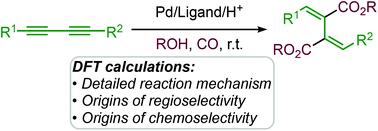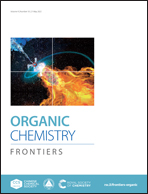Palladium-catalyzed regio- and chemoselective double-alkoxycarbonylation of 1,3-diynes: a computational study†
Abstract
The palladium-catalyzed double-alkoxycarbonylation of 1,3-diynes provides an efficient approach for the selective synthesis of 1,2,3,4-tetrasubstituted conjugated dienes. In this report, density functional theory calculations have been performed to elucidate the detailed reaction mechanism and the origins of the regio- and chemoselectivities. The computations show that the overall reaction involves two consecutive catalytic cycles with the same reaction mechanism. The catalytic cycle begins with the hydropalladation of the C–C triple bond via the N–H proton shuttle transfer to give a Pd–alkenyl intermediate, from which the CO insertion into the Pd–C bond occurs to form a Pd–acyl complex. The final product can be generated through alcoholysis with the assistance of the 2-pyridyl ring. The hydropalladation constitutes the rate- and regioselectivity-determining step. The computations very well reproduced the experimentally observed selectivity. The conjugated effect of the alkynyl group and the C–H⋯π interactions were identified as the key factors controlling the regioselectivity. The chemoselectivity between the alkoxycarbonylation of the C–C double and triple bonds was rationalized in terms of the steric repulsion and the interaction between the Pd center and C–C double bond.



 Please wait while we load your content...
Please wait while we load your content...